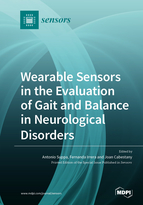Wearable Sensors in the Evaluation of Gait and Balance in Neurological Disorders
A special issue of Sensors (ISSN 1424-8220). This special issue belongs to the section "Biosensors".
Deadline for manuscript submissions: closed (24 April 2020) | Viewed by 85483
Special Issue Editors
Interests: pathophysiology of motor symptoms; Parkinson's disease (PD); human movement disorders; wireless and wearable technology; inertial measurement units (IMUs); early diagnosis; treatment of PD patients
Special Issues, Collections and Topics in MDPI journals
Interests: wearable electronics; More-than-Moore integration; nanoelectronics; CMOS device reliability; CMOS image sensors; innovative non-volatile memories
Special Issues, Collections and Topics in MDPI journals
Interests: movement diseases; people with gait problems; the application of electronic and communication engineering in Parkinson Disease; identification and measurement of Parkinson Disease-related symptoms and falls
Special Issues, Collections and Topics in MDPI journals
Special Issue Information
Dear Colleagues,
We are pleased to invite you to contribute to this Special Issue of Sensors entitled “Wearable Sensors in the Evaluation of Gait and Balance in Neurological Disorders”. The aim of this Special Issue is to collect the most up-to-date information about the objective evaluation of gait and balance impairment, by means of biosensors (IMUs, etc), in patients with various types of neurological disorders including Parkinson’s disease, dystonia, cerebellar ataxia, multiple sclerosis, stroke, and spasticity. We will accept full-length research articles and reviews focused on this research topic. We hope this initiative will encourage new ideas and produce unparalleled networking opportunities in the field.
Prof. Dr. Antonio Suppa
Prof. Dr. Fernanda Irrera
Prof. Dr. Joan Cabestany
Guest Editors
Manuscript Submission Information
Manuscripts should be submitted online at www.mdpi.com by registering and logging in to this website. Once you are registered, click here to go to the submission form. Manuscripts can be submitted until the deadline. All submissions that pass pre-check are peer-reviewed. Accepted papers will be published continuously in the journal (as soon as accepted) and will be listed together on the special issue website. Research articles, review articles as well as short communications are invited. For planned papers, a title and short abstract (about 100 words) can be sent to the Editorial Office for announcement on this website.
Submitted manuscripts should not have been published previously, nor be under consideration for publication elsewhere (except conference proceedings papers). All manuscripts are thoroughly refereed through a single-blind peer-review process. A guide for authors and other relevant information for submission of manuscripts is available on the Instructions for Authors page. Sensors is an international peer-reviewed open access semimonthly journal published by MDPI.
Please visit the Instructions for Authors page before submitting a manuscript. The Article Processing Charge (APC) for publication in this open access journal is 2600 CHF (Swiss Francs). Submitted papers should be well formatted and use good English. Authors may use MDPI's English editing service prior to publication or during author revisions.
Keywords
- Wearable sensors
- IMU
- Gait
- Balance
- Parkinson’s disease
- Movement disorders
- Neurology
- Real time monitoring
- Longitudinal monitoring
- Home monitoring









